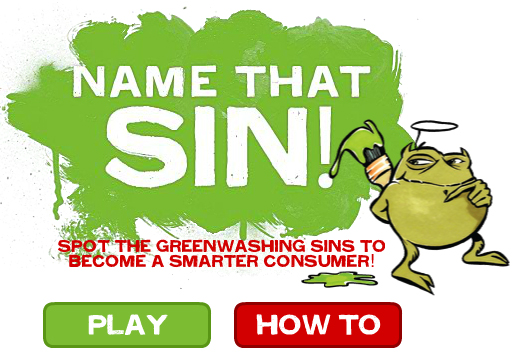The Sins of Greenwashing: Home and Family Edition
Underwriters Laboratories
This interactive game, sponsored by Underwriters Laboratories, is designed to educate consumers about “greenwashing,” defined on the site’s home page as “the act of misleading consumers regarding the environmental practices of a company or the environmental benefits of a product or service.” This site offers consumers information in various formats about the environmental claims of companies. What do you think about labeling these greenwashing tactics as “sins”?

© [2014] UL LLC. Reprinted with permission.
<<COMP: insert Figure ePages 16.3>>
Reading as a Writer: Analyzing Rhetorical Choices
After exploring The Sins of Greenwashing, consider the question below. Then “submit” your response.
Question 16.4
1. Spend five to ten minutes playing the game, “Name that Sin.” Try both the “Play” and “How To” options, and pay attention to the ways the information is presented to you. What can you say about the images, tone, and data the game teaches those who plan it? What did you learn?
<<textbox>>
Writing like a Reader: Entering the Conversation of Ideas
After exploring The Sins of Greenwashing, consider the questions below. Then “submit” your response.
Question 16.5
1. Consider this Web site, and its cautionary attitude toward marketing ploys that entice us to buy products that are often falsely labeled as “environmentally friendly,” in relation to the excerpt of Derrick Jensen and Stephanie McMillan’s use the graphic novel, “As the World Burns: 50 Simple Things You Can Do to Stay in Denial.” Take notes on the ways each text teaches the reader information, using inventive tactics and tone. What do you conclude about effective ways to teach people accurate information about environmental issues? Write informally or develop a more formal essay on this topic, using these sources.
<<textbox>>
Question 16.6
2. “Greenwashing” tactics like those exposed in this website are also the focus of essays by Carolyn Merchant and Noël Sturgeon in this chapter. Develop an essay in which you consider the ways these texts are in conversation with one another. How do the insights compliment, extend, or perhaps contradict one another in their arguments about exposing “false advertising” about environmentally conscious consumption? Where do your ideas fit into this conversation?
<<textbox>>
<<Settings>>